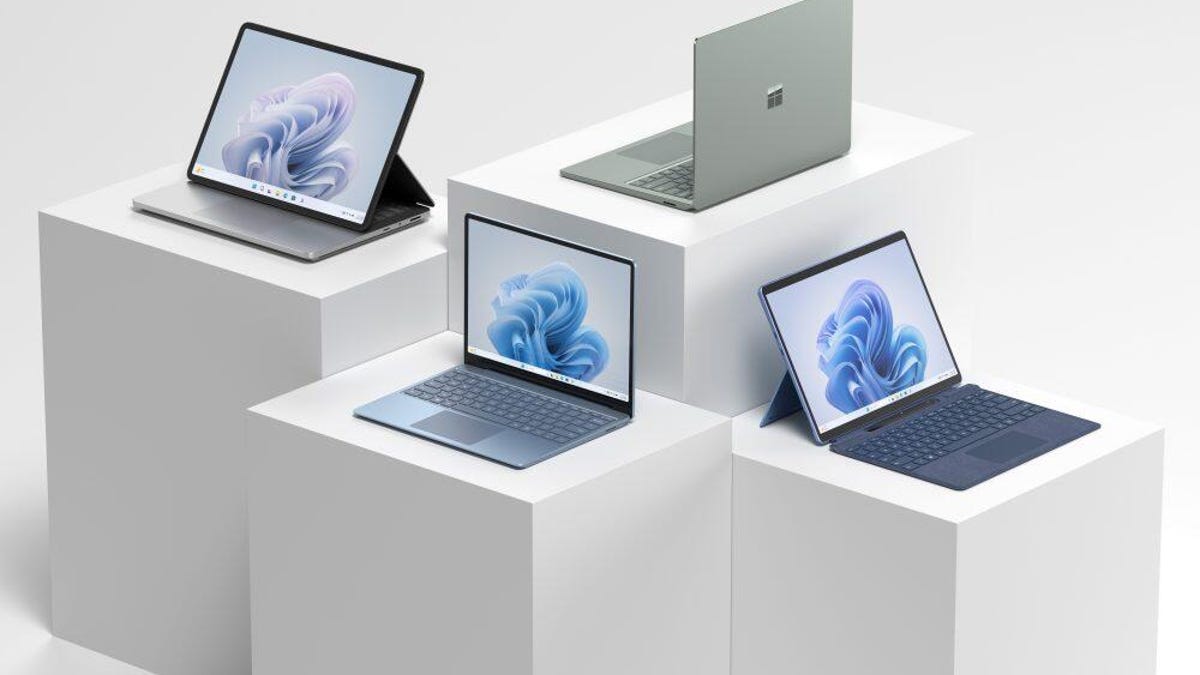Microsoft Refreshes 3 Surface Lines With Internals Fit for Its AI
The premium Surface Laptop Studio 2, budget Surface Laptop Go 3 and detachable Surface Go 4 for Business will feature Windows Copilot and upgraded parts.

At its AI and Surface event Thursday, Microsoft announced AI upgrades to Windows 11, headlined by Windows Copilot, and updates to three of its Surface devices: the premium Surface Laptop Studio, budget Surface Laptop Go and Surface Go detachable two-in-one. The new devices, with updated internals, should be peppier than their predecessors and will feature the next update to Windows 11, which will introduce Copilot, which Microsoft calls "your everyday AI companion." And as expected, the hardware updates were mostly in service of running it better.
Surface Laptop Studio 2
The second-gen Surface Laptop Studio gets updated internals, but it remains largely unchanged on the exterior from the original Surface Laptop Studio released two years ago.
Microsoft replaced the mechanical Precision touchpad with a haptic version, which is therefore more programmable. It's capable of recognizing more than just finger-based input for people who have issues with touchpads. Its adaptive touch mode gives it the ability to use it like a mouse and to toggle it into a mode that better senses parts of your body rather than fingers. Although the Slim Pen 2 included with the Studio 2 hasn't changed, Microsoft is now offering adaptive grips for them as well.
Plus, the Studio 2 gets a micro SD card Slot and USB-A port, which hopefully decreases the number of accessories, including hubs and card readers, a lot of creatives would otherwise need to tote around. You still get two USB-C ports with Thunderbolt 4 support from the previous model.
It incorporates the same 14.4-inch PixelSense display as before -- 3:2 aspect ratio, 120Hz refresh rate and 2,400x1,600-pixel resolution -- but a new display controller (the TCON) now allows it to perform the 10-bit math necessary for HDR beyond basic streaming video. The lack of HDR has long been a frustration about the PixelSense screens. It's now DisplayHDR 400 certified (which isn't great because that's barely HDR), with brightness peaking at 500 nits in SDR and 650 nits in HDR mode.
A new USB-A port shouldn't feel as exciting as it does.
Unfortunately, since it's the same panel, it has the same color gamut, which is only large enough to cover sRGB, not P3 or Adobe RGB -- at least one of which I expect to be in a laptop intended for creative design and for its price.
Inside, Microsoft has added Intel's Movidius 3700VC VPU processor, which it refers to as the neural processing unit, to accelerate AI-related tasks and Windows features that use it. That includes processing the video from the new wider angle (still 1,080p) webcam's Windows 11 features like the creepy eye contact, background blur and automatic framing. And for a little more oomph than the CPU alone can handle for generative AI creative tasks.
It offers updated chips from Intel and Nvidia and expanded RAM and storage options. The base model features a Core i7-13700H CPU with integrated graphics, with upgrade options for a 6GB Nvidia GeForce RTX 4050, 8GB RTX 4060 GPU or the workstation version of the RTX 4060, the RTX 2000. You can configure it with up to 64GB of RAM and a 2TB SSD -- both double the maximum offered on the previous version. Intel's 13th-gen chips also deliver an upgrade to Wi-Fi 6E and Bluetooth 5.3.
The Surface Laptop Studio 2 starts at $1,999, which is high for a base system that only has Iris Xe integrated graphics, 16GB RAM, 512GB SSD storage and an i7. I suspect the design of the display, which you can lay flat on top of the keyboard section to use like a tablet for graphics work, sets the lower bound on the price.
Surface Laptop Go 3
The current Surface lineup with the four Laptop Go 3 colors in the middle, sandwiched between the Surface Go 4 and the Surface Studio 2.
The Surface Laptop Go 3 received a modest upgrade from last year's to a Core i5-1235U CPU. While not earth-shattering, the Surface Laptop Go 2 was based on a Core i5-113G7 chip, the last generation before Intel switched to its modern P-core/E-core architecture, similar to Apple's M series, that delivers better performance and battery life. The starting price of $799 remains unchanged, as does the 12.4-inch, 3:2 touch display with a 1,536x1,024-pixel resolution.
Why a previous 12th-gen Intel Core chip instead of the more recent 13th gen in a product released in 2023? Primarily intended for the K-12 education market, Microsoft updates the Surface Laptop Go at a slower pace because schools need stability in configurations from year to year to ease replacement and upgrade costs.
Surface Go 4 for Business
Microsoft's smallest detachable two-in-one also received an internal upgrade. The 10.5-inch device remains the same on the outside as the Surface Go 3, but adds a quad-core Intel N200 processor, replacing the previous version's dual-core Core i3-10100Y chip. The baseline model now supplies 8GB of RAM, instead of the meager 4GB of memory you got with the entry-level Go 3. For storage, 64GB remains the entry point, but the Surface Go 4 now lets you expand the storage to 256GB, double the previous maximum.
While the Surface Go 4 for Business will look no different from its predecessor, it has been redesigned on the inside to be more easily repaired, an important consideration for businesses or schools looking to extend the life of their current fleet of devices that take daily abuse from workers in the field or students. Replaceable parts on the new model include the display, back cover, battery, kickstand, hinge, cameras and motherboard.
The new devices will start shipping on Oct. 3.



